Quick Summary:
Technological advancements have become an integral part of our life. With the new dawn of the competitive marketplace, AR is a recently surged concept crucial in solving various business challenges, whether in the business industry, retail, gaming, healthcare, or even the military. However, the development of the applications creates a dilemma among business owners when choosing an ideal tech stack. Flutter is the one widely popular tech stack that offers a broad stratum of solutions to enhance the overall experience of your users. In this blog post, we will cover round-the-corner aspects of these applications, and reasons to choose them, accompanied by the step-by-step tutorial for building Flutter Augmented Reality Applications, their Use Cases, and the Companies that benefit from AR apps with Flutter.
Table of Contents
Introduction to AR Apps with Flutter
Talking about building AR Apps with Flutter we know, Flutter is a renowned software development kit by Google to develop cross-platform applications that include platforms such as Android, iOS, Mac, Windows, Linux, and Google Fuchsia. According to the StackOverflow Development Survey 2022, it is the sixth most popular language among the development community, with 12.64% votes. It is destined to grow in the future with organizations leveraging the cross-platform functionality it offers.
Augmented Reality, on the other hand, is the real-time integration of digital information with the user’s environment with the generated perpetual information overlaid. It changes the natural environment; simply, it bends the digital and 3D components with real-world perceptions, contrary to the virtual Reality that creates an artificial environment.
Why Choose Flutter for Building AR Applications?
There are many reasons why Flutter is your go-to choice for generating next-gen Mixed Reality experiences. Let us look at a few features of Flutter that contribute to developing exceptional mixed-reality applications:
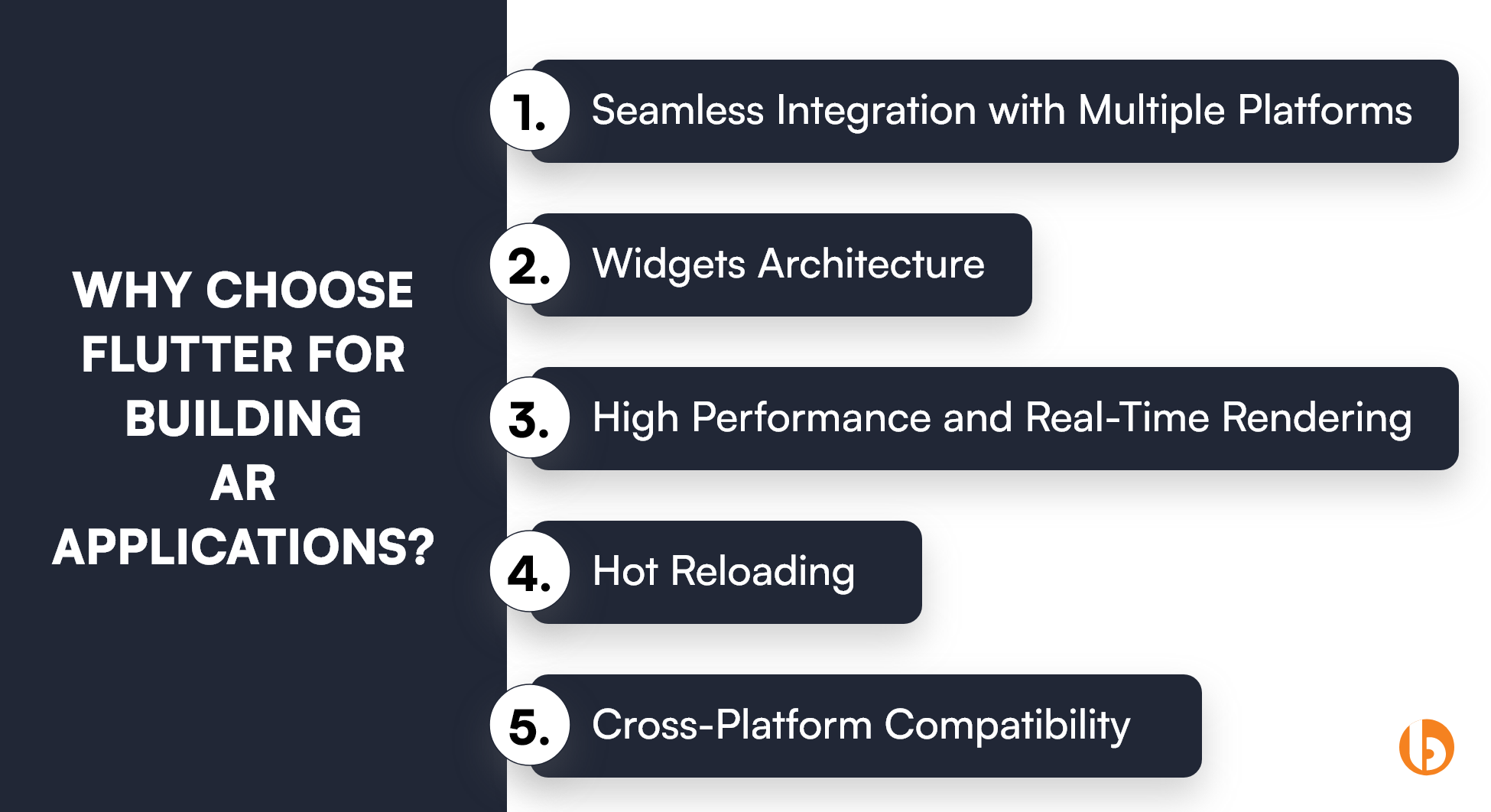
🟠 Seamless Integration with Multiple Platforms
The Flutter plugin (ARKit for iOS and ARCore for Android) provides access to mobile sensors, cameras, and functionalities such as motion tracking, light estimation, and environmental understanding, making it easier for product owners to deliver compelling Augmented Reality experiences.
🟠 Widgets Architecture
It presents a widget-based architecture to help build widgets or components tailored to your requirements. These widgets can include 3D models, overlays, animations, interactive elements, and more to enhance your Flutter Augmented Reality experience. Also, its flexibility in UI design allows you to craft unique and visually appealing interfaces.
🟠 High Performance and Real-Time Rendering
It uses the Skia rendering engine, renowned for its performance-centric approach that includes real-time rendering and virtual object tracking that ensures smooth animation and responsive interaction for upscaling the overall experience.
🟠 Hot Reloading
This feature in your Flutter app allows you to change the code and instantly observe the app updates in real-time without restarting the whole application. Also, it facilitates rapid iterations, allowing you to experiment with the mixed reality elements, test interactions, and refine app behavior in real time.
🟠 Cross-Platform Compatibility,
The popularity of Flutter apps is mainly due to their cross-platform functionality, which means you write a single code and run it on any platform, whether it is iOS, Android, Windows, Mac, Linux, or others. It reduces the time and effort and offers more time to create better-augmented reality functionality and fine-tune the user experience.
Want to Bring Your AR App Vision to Reality? 📈
Unleash the power of AR with our experts. Hire Flutter Developer from us for an extraordinary AR app development experience.✨
ARCore and ARKit
ARCore and ARKit are software development platforms that function as the Flutter plugin that enables the Augmented Reality experience on mobile devices.
The ARCore is a platform by Google for building AR applications on Android devices. It offers tools and APIs to build immersive experiences that blend virtual content with reality. ARCore acts as a Flutter plugin that uses a combination of motion tracking, environmental understanding, and light estimation, allowing you to place virtual objects into reality, detect surfaces for anchoring virtual content, and interact with the real-time environment. ARCore is compatible with a wide range of Android devices to help you reach a broad audience for new Augmented Reality Experiences.
On the other hand, ARKit is a set of tools, libraries, and APIs by Apple for building compelling AR experiences on Apple devices. It leverages your device camera, motion sensors, and scene analysis to enable object tracking, surface detection, and real-time lighting estimation to help you integrate immersive and interactive virtual content with reality.
ARKit shares many similarities with ARCore, with the core difference being that Apple-exclusive support works well with SceneKit and SpriteKit.
Step-by-Step Tutorial: Building AR Apps in Flutter
Before we jump into the details of this step-by-step tutorial to build Flutter AR Applications, it is essential to know the prerequisites needed to develop your Flutter app.
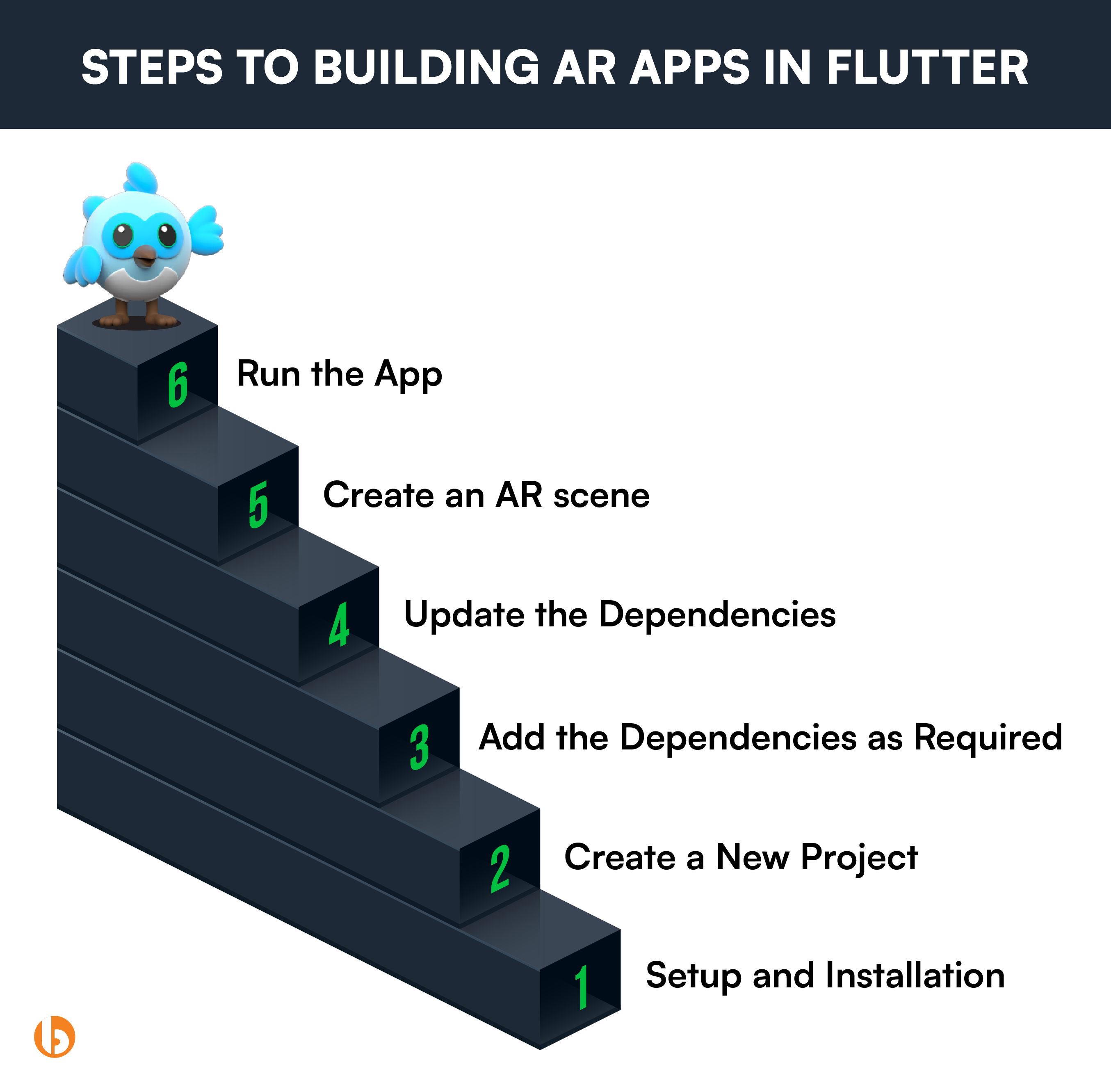
Prerequisites
- Initially, you need the latest version of the Flutter SDK installed on your system; you can download it from here.
- You require an IDE or a Text Editor, such as Android Studio or Visual Studio Code, along with the Dart plugins/extensions installed.
- Get an Emulator or Physical Device for testing the AR apps with Flutter. Ensure both support the ARCore (Android) or ARKit (iOS) functionalities.
- Also get the Packages whereby you can use ‘arcore_flutter_plugin’ for Android and ‘arkit_flutter_plugin’ for iOS AR functionality.
- Add the required dependencies in your project’s ‘pubspec.yaml’ file and run ‘flutter pub get’ to download the packages.
Step-1 Setup and Installation
- Initially, Install Flutter by following your operating system’s official installation guide.
- Then, Set up an IDE of your choice, like Android Studio or Visual Studio Code, and install the Flutter and Dart plugins.
Step 2: Create a New Project.
Open your terminal or command prompt (cmd) and run the following command as given below:
The above command will create a new project named “ar_app.”
Step 3: Add the Dependencies as Required
Open the yaml file (pubspec.yaml) in your project directory and add the dependencies as given below:
These will help you integrate Augmented Reality when building your AR apps with Flutter.
Note: Replace latest_version with the most recent version of the respective plugins.
Step 4: Update the Dependencies
Run the following command in the terminal to download and update the added ones:
Step 5: Create an AR scene
Open the dart file (lib/main.dart).
Replace the existing code with the following sample code to create a generic AR scene:

import 'package:flutter/material.dart';
import 'package:arcore_flutter_plugin/arcore_flutter_plugin.dart';
import 'package:arkit_plugin/arkit_plugin.dart';
void main() => runApp(ARApp());
class ARApp extends StatelessWidget {
@override
Widget build(BuildContext context) {
return MaterialApp(
home: ARScene(),
);
}
}
class ARScene extends StatefulWidget {
@override
_ARSceneState createState() => _ARSceneState();
}
class _ARSceneState extends State {
ARKitController arkitController;
@override
void dispose() {
arkitController.dispose();
super.dispose();
}
@override
Widget build(BuildContext context) {
return Scaffold(
appBar: AppBar(
title: Text('AR Scene'),
),
body: ARKitSceneView(
onARKitViewCreated: onARKitViewCreated,
enableARKit: true,
enableARKitLightEstimate: true,
),
);
}
void onARKitViewCreated(ARKitController arkitController) {
this.arkitController = arkitController;
final node = ARKitNode(
geometry: ARKitBox(
width: 0.2,
height: 0.2,
length: 0.2,
chamferRadius: 0.0,
),
position: ARKitVector3(0, 0, -0.5),
eulerAngles: ARKitVector3(0, 0, 0),
lightingModelName: ARKitLightingModel.lambert,
);
arkitController.add(node);
}
}
The code above will set up a basic augmented reality scene using the arcore_flutter_plugin for Android and the arkit_flutter_plugin for iOS. It creates a box-shaped 3D object for the AR scene.
Step 6: Run the App
Then, Connect a physical device or set up an emulator/simulator.
Navigate to your project directory and run the command below:
This above code will deploy and run the AR application on your device/emulator.
Congratulations! You have successfully created a basic Flutter Augmented Reality app. You can now explore and enhance your experience by adding more objects and interactions or integrating additional functionalities provided by the AR plugins.
Types of Augmented Reality and Their Working
Generally, five types of Augmented Reality can help you build your Flutter Augmented Reality application and implement its functionalities. However, their use case depends on the functionality you aim to implement within your application. Let us look at the name of it and circumferentially understand their working.
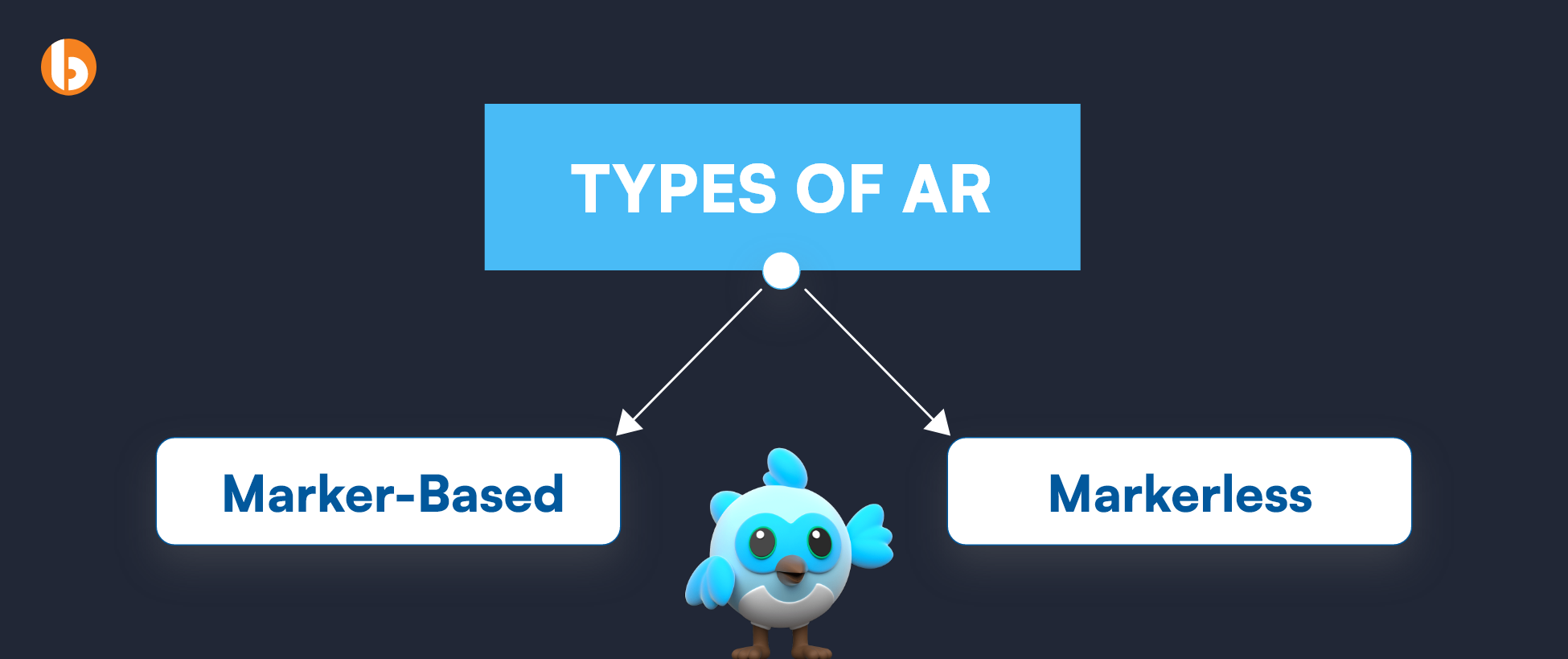
🟠 Marker-Based
These are the image recognition ARs, which rely on a QR code or a visual marker, also renowned as the fiduciary marker, to initiate the interactive experience. You must scan the marker with your smartphone camera to activate the visual effects. After that, you can see the digital image in 3D on your screen. The one limitation is that you need a mobile device, such as a smartphone or tablet, and a dedicated app to function.
🟠 Markerless
These do not rely on physical markers like QR codes or images but use the data from GPS or accelerometers in mobile devices to detect and track the user environment and determine the location of the virtual content. It enables your app to understand the spatial relationships and orientation of things and surfaces in the user’s view and superimpose the virtual content accordingly. It can work on irregular surfaces as long as there are recognizable, like corners, textures, and objects to track. Note that the complexity and variability of the environment impact its accuracy. However, it is more complex and costly but also the most popular option in online shopping and gaming.
Markerless also has three other AR Types that are:
Projection-Based: It relies on projectors to display 3D imagery or digital content onto a flat two-dimensional surface, like a wall, floor, or object. It doesn’t create fully immersive environments, mainly holograms for events and movies. You can use it for in-person events like store openings or pop-up shops, where you can show holograms.
Superimposition-Based: It wholly or partially replaces physical objects with a digital augmentation, such as a book cover, a product label, or a landmark, then overlays the relevant digital content onto the object or feature. It can offer a more interactive experience to customers, for example, laying virtual arrows onto the environment or enabling the functionality that allows them to get product information by pointing the smartphone camera at a product along with other details.
Location-Based: It relies on geographic data to deliver digital images at specific locations, making it popular for gaming, whereby the most prominent one is Pokémon Go. Companies that want to gamify the shopping experience could use it to encourage shoppers to interact with their products. For instance, you could create a virtual scavenger hunt, encouraging shoppers to explore your store and collect rewards.
Use Cases of AR Applications Built with Flutter
Flutter for web development is ideal for developing web applications such as PWAs or SPAs and bringing your existing mobile app to the web. However, other exciting use cases exist when building AR apps with Flutter. The versatility of this technical advancement opens up numerous possibilities across various industries, enabling innovative and engaging customer experiences. Here are some examples:
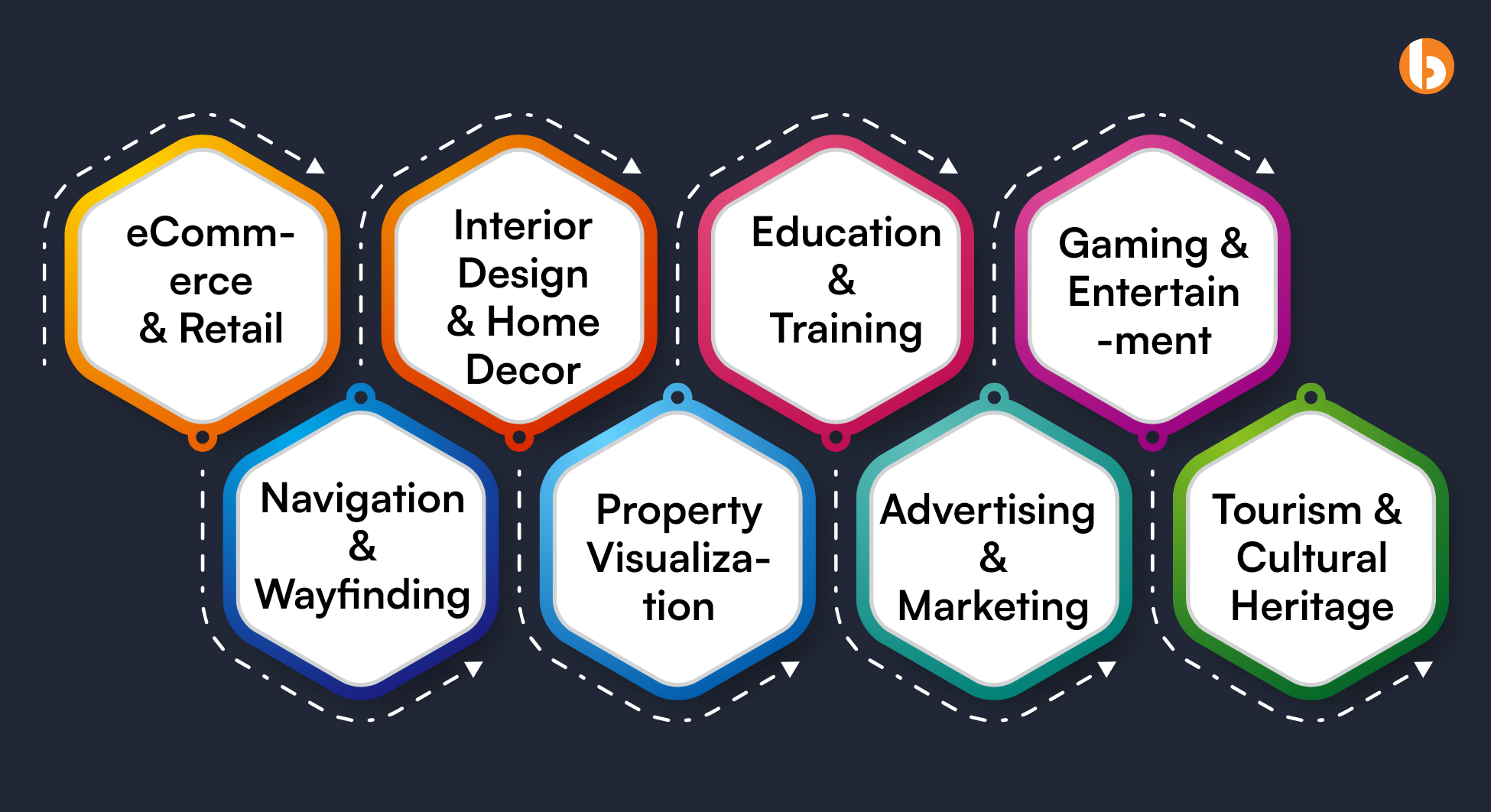
🟠 eCommerce and Retail
Augmented Reality can enhance the shopping experience by allowing interactive and realistic previews to try on clothing, accessories, or test makeup virtually and more. You can use their device’s camera to see how products look on themselves in real-time, helping them make informed purchase decisions, ultimately benefiting the eCommerce and Retail industries to boost customer engagement and drive sales.
🟠 Interior Design and Home Decor
Within the interior design and home decor industry, augmented reality applications allow customers to place furniture and decor items virtually and even paint colors within their homes, whereby they can also visualize how different pieces will look and experiment with various styles and layouts. This enhances the customer experience by showing how products will fit and complement their existing spaces. It eliminates guesswork and allows customers to visualize the result, reducing the risk of dissatisfaction with purchases.
🟠 Education and Training
Within this industry, they can bring educational content to life by overlaying virtual objects, simulations, and interactive elements onto the real-world environment. It enables students to visualize complex concepts, perform virtual experiments, and engage in interactive exercises, enhancing their understanding and retention of the subject matter.
In training scenarios, AR in Flutter allows learners to simulate real-world environments and practice skills in a safe and controlled manner. They can receive step-by-step guidance, receive immediate feedback, and refine their techniques through simulations. This hands-on approach accelerates learning and skill development.
🟠 Gaming and Entertainment
The games powered by Mixed Reality allow players to interact with virtual objects and characters overlaid in their physical environment, opening up endless possibilities for unique gameplay mechanics, such as physical movement, object recognition, and gesture-based controls. Players can engage in treasure hunts, battles, and puzzles that seamlessly integrate with their surroundings, creating a truly interactive and dynamic gaming experience.
🟠 Navigation and Wayfinding,
The AR wayfinding in Flutter enables customers to locate points of interest quickly and possess landmarks, businesses, or specific destinations. Utilizing the device’s camera and sensors can overlay digital information onto real-world entities using the device’s camera and sensors, providing contextual information and guiding the user to desired locations. Also, it allows for augmented reality indoor mapping where they can navigate through large buildings, airports, or shopping malls with visual overlays that indicate paths, points of interest, and relevant information, simplifying navigation in complex indoor environments and helping them find their way efficiently.
🟠 Real Estate and Property Visualization
Augmented Reality in this industry allows you to view, engage and interact more through your mobile devices. Also, you can superimpose virtual models of buildings, apartments, or houses in real-time and experience how they look in different locations or assess their compatibility with existing surroundings.
You can explore properties from different angles, walk through virtual rooms, and understand the spatial layout. They can also interact with virtual furniture and decor, enabling them to customize and personalize the virtual space to suit their preferences. This level of immersion and interactivity enhances the decision-making process and helps potential buyers or renters envision themselves in the property.
🟠 Advertising and Marketing
It allows brands to bring their products or services to life by overlaying digital content with reality. Users can use their devices to view AR advertisements that seamlessly blend with their surroundings, enhancing the overall impact and memorability of the message. This immersive approach creates a unique and personalized consumer experience, fostering deeper engagement and brand recall.
It also enables interactive product visualization and try-on experiences. Users can virtually “try on” clothing, accessories, and makeup or see how furniture or decor items would look in their spaces. This interactive aspect of AR advertising allows consumers to engage with products more meaningfully, leading to increased confidence and conversion rates.
🟠 Tourism and Cultural Heritage
Tourism and cultural heritage have been greatly enriched by integrating augmented reality (AR) technology using Flutter. By leveraging AR capabilities, developers can create immersive and interactive experiences that enhance the exploration and understanding of tourist destinations and cultural sites.
The tourism apps in Flutter enable users to discover and explore destinations more engaging and informatively. Users can use their mobile devices to overlay digital information, such as historical facts, points of interest, or virtual guides, onto the real-world environment giving the visitors a unique and enriched perspective, allowing them to delve deeper into the history, culture, and significance of the places they visit.
It also allows for virtual reconstructions of historical sites or landmarks, showcasing how they might have looked in the past. Users can virtually step back in time and witness the evolution of cultural heritage sites, enhancing their understanding and appreciation of their historical and architectural significance.
Companies Excelling in AR Applications with Flutter
As technology takes over the traditional user experience, many companies have realized the potential of AR applications with Flutter, projecting how it can help build immersive and interactive experiences across different industries. However, with further advancements, many more brands and companies will adopt AR feature points whereby Flutter can play an important role in helping them decide. Let us look at a few companies that chose to leverage the potential of Flutter to create innovative AR applications.
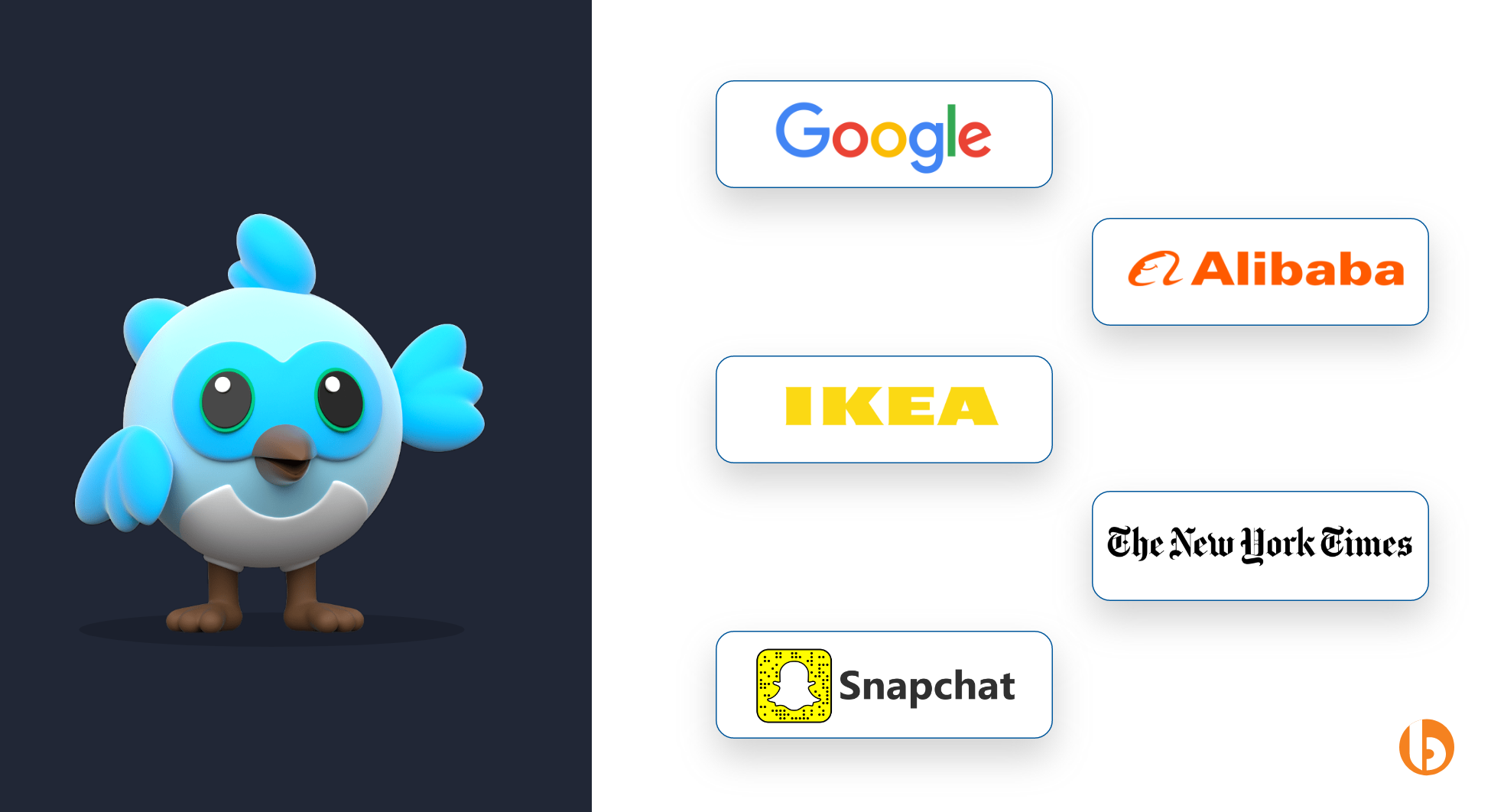
Being the mind behind the creation of Flutter, Google actively strives to advance the AR capabilities in Flutter apps. The core reason behind this popularity is Google’s expertise in AR technology and commitment to Flutter, making them a prominent player in Augmented Reality with Flutter space.
Alibaba
The renowned multinational conglomerate has demonstrated its commitment to augmented reality by utilizing the capabilities of Flutter. It has developed AR experiences for its e-commerce platforms, enabling users to virtually try on makeup, clothing, and accessories in real-time.
IKEA
The furniture giant IKEA has also chosen to leverage the power of Flutter. It has incorporated AR functionality into its mobile app, letting users preview how furniture and home decor items would look in their homes, further enhancing the shopping experience for its customers.
The New York Times
The New York Times utilized Flutter to build interactive storytelling experiences. They created AR applications that bring their news stories to life, enabling users to engage with the content in an immersive and interactive way.
Snapchat
Though Snapchat does not exclusively use Flutter, it has integrated it into its development pipeline, combining its AR capabilities with Flutter UI capabilities to create engaging face filters and effects for Snapchat users.
Conclusion
It summarizes what we have for you in this tutorial blog on Augmented Reality in Flutter. And with the data details above, it is an excellent choice for developing AR apps with Flutter. If you are also a business owner and are confused if it is your go-to choice for your next development project, then you can consider partnering with a Flutter App Development Company like Bacancy to help you guide through the process and make the right choice to get the most out of your Flutter Augmented Reality application.
Frequently Asked Questions (FAQs)
The main difference between the two is their interaction with reality. AR enhances the real-life experience by overlaying digital content, while VR creates an entirely virtual environment that replaces the real-life experience.
While Flutter provides a robust platform for AR app development, it’s important to consider device compatibility and performance limitations. Some older devices may not support full AR capabilities, and optimizing the app’s performance is crucial for a smooth AR experience.
You can build marker-based AR interactions by combining Android, which supports ARCore Flutter Plugin, and iOS supports ARKit. Also, you can detect markers or images and overlay virtual content on top of them.
Yes, there are sample projects, tutorials, and documentation available for AR development in Flutter. You can refer to the official documentation and repositories of the ARCore Flutter Plugin and ARKit Flutter Plugin for comprehensive guides, examples, and code samples to get started with AR app development in Flutter.
Currently, Flutter focuses primarily on mobile app development for Android and iOS. However, Flutter for Web (Hummingbird) is an experimental project that may offer the potential for creating web-based AR experiences in the future.
Flutter seamlessly allows you to blend 2D UI elements with AR content. You can overlay Flutter widgets on top of the AR view or position them relative to the AR content to create engaging and interactive AR experiences.
Your Success Is Guaranteed !
We accelerate the release of digital product and guaranteed their success
We Use Slack, Jira & GitHub for Accurate Deployment and Effective Communication.





